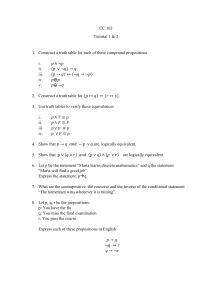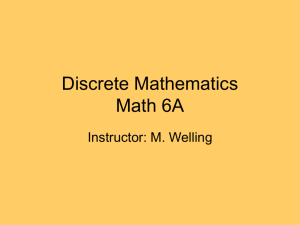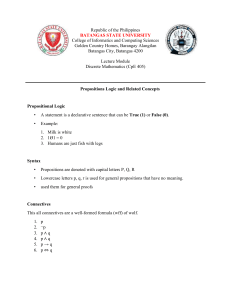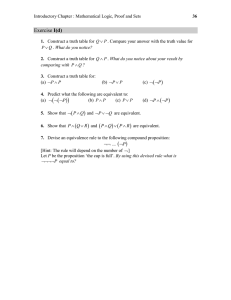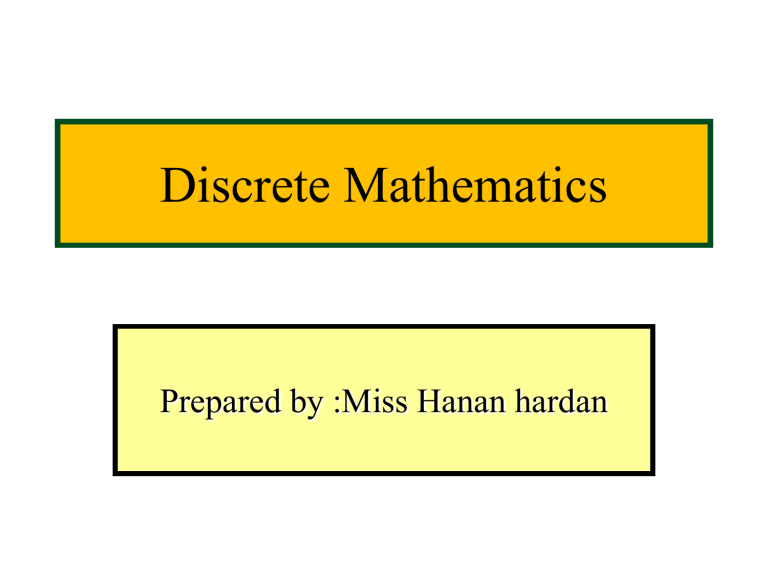
Discrete Mathematics
Prepared by :Miss Hanan hardan
3/15/2022
Course Contents
Logic
Sets and Set Operations
Integers, Division and Matrices
Relations
Functions
Sequences and summation
Graphs
Trees
2
Section 1.1: The Foundations: Logic
• Mathematical Logic is a tool for working with compound
statements
• Use of logic
– In mathematics:
to prove theorems
– In computer science:
to prove that programs do what they are supposed
to do
Section 1.1: Propositional Logic
Definition of a Proposition
• Proposition is a declarative statement (that declares a fact)
• Proposition is a statement that is either True (T) or False
(F), but not both
• Propositions can be denoted by Letters (p, q, r, ..)
– True value can be denoted by T.
– False value can be denoted by F.
Note: Commands and questions are not propositions.
Examples of Propositions
• The following are all propositions:
– “It is raining” (In a given situation)
– “Amman is the capital of Jordan”
– “1 + 2 = 3”
– 1 + 1 = 4. (False) since, 1 + 1 = 2
• But, the following are NOT propositions:
– “Who’s there?” (Question)
– “La la la la la.” (Meaningless)
– “Just do it!” (Command)
– “1 + 2” (Expression with a non-true/false value)
– “1 + 2 = x” (Expression with unknown value of x)
– C++ is the best language (Opinion)
Examples of Propositions
Q: Are these propositions?
– 2+2=5
– Every integer is divisible by 12
– Microsoft is an excellent company
Examples of Propositions
• Propositions can be:
– Atomic: consists of single proposition.
– Compound: consists of one or more propositions
connected by logical operators.
– P: Today is Friday. : F
– Q: 1 + 1 = 2.
:T
– R: P Q
:F
Atomic
Atomic
Compound
Some Popular Boolean Operators
Formal Name
Nickname
Arity
Symbol
Negation operator
NOT
Unary
¬
Conjunction operator
AND
Binary
Disjunction operator
OR
Binary
XOR
Binary
IMPLIES
Binary
IFF
Binary
↔
Exclusive-OR operator
Implication operator
Biconditional operator
The Negation Operator
Definition: Let p be a proposition then ¬p is the negation of
p (Not p , it is not the case that p).
EX: If P = “London is a city.”
then ¬p = “London is not a city” or “ it is not the case that
London is a city”
The truth table for NOT:
p p
F T
T F
Operand
column
Result
column
The Conjunction Operator
Definition: Let p and q be propositions, the proposition “p
AND q” denoted by (p q) is called the conjunction of p
and q.
Conjunction is True, if both P and q are true.
e.g. If p = “I will have salad for lunch” and
q = “I will have steak for dinner”, then
p q = “I will have salad for lunch and
I will have steak for dinner”
Remember: “” points up like an “A”, and it means “AND”
Conjunction Truth Table
• Note that a
conjunction
p1 p2 … pn
of n propositions
will have 2n rows
in its truth table.
Operand
columns
p
F
F
T
T
q
F
T
F
T
Result
column
pq
F
F
F
T
“And”, “But”, “In addition to”, “Moreover”.
The Disjunction Operator
Definition: Let p and q be propositions, the proposition “p
OR q” denoted by (p q) is called the disjunction of p
and q.
It is True, if any of P and q is true.
• EX: Student who have taken calculus or computer
science can take this class
Disjunction Truth Table
• Note that p q means
that p is true, or q is
true, or both are true!
• So, this operation is
also called inclusive or,
because it includes the
possibility that both p and q are true.
p
F
F
T
T
q pq
F F
T T
F T
T T
Note the
differences
from AND
Compound Statements
• Let p, q, r be simple statements
• We can form other compound statements, such as
(p q) r
p (q r)
¬p ¬q
(p q) (¬r s)
and many others…
A Simple Exercise
Let p = “It rained last night”,
q = “The sprinklers came on last night” ,
r = “The grass was wet this morning”.
Translate each of the following into English:
¬p
= “It didn’t rain last night”
r ¬p
= “The grass was wet this morning, and
it didn’t rain last night”
¬rpq =
“Either the grass wasn’t wet this
morning, or it rained last night, or
the sprinklers came on last night”
The Exclusive Or Operator
The binary exclusive-or operator “” (XOR) combines two
propositions to form their logical “exclusive or”
(exjunction?).
It is True, if any of P and Q is true, but not both.
e.g. p = “I will earn an A in this course”
q = “I will drop this course”
p q = “I will either earn an A in this course, or
I will drop it (but not both!)”
Exclusive-Or Truth Table
• Note that p q means
that p is true, or q is
true, but not both!
• This operation is
called exclusive or,
because it excludes the
possibility that both p and q are true.
p
F
F
T
T
q pq
F F
T T
F T
T F
Note the
difference
from OR
Natural Language is Ambiguous
Note that English “or” can be ambiguous regarding the “both”
case!
“Pat is a singer or
Pat is a writer”
“Pat is a man or
Pat is a woman”
Need context to disambiguate the meaning!
For this class, assume “OR” means inclusive.
The Implication Operator
hypothesis
conclusion
The implication p q states that p implies q.
If p is true, then q is true; but if p is not true, then q could be
either true or false.
e.g. Let p = “You get 100% on the final”
q = “You will get an A”
p q = “If you get 100% on the final, then
you will get an A”
Implication Truth Table
• p q is false only when
p is true but q is not true.
p
F
F
T
T
q pq
F
T
T T
F
F
T T
The
only
False
case!
The Implication Operator
• P Q has many forms in English Language:
– "P implies Q"
– " If P, Q"
– "If P, then Q"
– "P only if Q“
– "P is sufficient for Q"
– "Q if P"
– “Q when P"
– “Q whenever P”
– “Q follows from P”
Converse, Inverse, Contrapositive
Some terminology, for an implication p q :
• Its converse is:
q p
• Its inverse is:
¬p ¬q
• Its contrapositive is: ¬ q ¬ p
Example of Converse, Inverse,
Contrapositive
Write the converse, inverse and contrapositive of the
statement “if it is raining, then it is cloudy.”
Converse
QP
Contrapositive
Q P
Inverse
pQ
If it is cloudy, then it is
raining
If it is not cloudy, then it is
not raining
if it is not raining, then it
is not cloudy
Note: The negation operation (¬) is different from the
inverse operation.
Example of Converse, Inverse,
Contrapositive
Proving the equivalence of p q and its contrapositive using
truth tables:
p
F
F
T
T
q q
F T
T F
F T
T F
p
T
T
F
F
pq q p
T
T
T
T
F
F
T
T
Biconditional Truth Table
• It is denoted by PQ, and it is read as "P if and only if
Q"
• It is true, if P and Q both have the same truth value.
• Note this truth table is the exact opposite of ’s!
Thus, P Q means ¬(P Q)
In English:
• “p if and only if q "
• "If p, then q, and conversely"
• “p is sufficient and necessary for q "
p
F
F
T
T
q pq
F T
T F
F F
T T
Examples:
USING:
– P: John has a cat.
– Q: John has a dog.
– R: Today is sunny.
– S: it rains.
– T: I wear my coat.
WE CAN BUILD:
– ~R: Today is not sunny.
– P Q: John has a cat and a dog.
– P Q: John has a cat or a dog.
– P Q: John has a pet; it is either a cat or a dog.
– S T: If it rains, I will wear my coat.
– S T: If it rains, I will wear my coat, and conversely
Truth Tables of Compound
Proposition:
• Note: If a compound proposition has n distinct simple
components, then it will have 2n rows in its truth table, as
this is the number of possible combinations of n
components, each with 2 possible truth values T or F.
• Precedence of Logical Operators
Operator
()
¬
,
,
Left to Right
Precedence
1
2
3
4
5
Example: Truth Table of (pq)r
p
q
r
pq
(p q) r
F
F
F
F
F
F
F
T
F
F
F
T
F
T
F
F
T
T
T
T
T
F
F
T
F
T
F
T
T
T
T
T
F
T
F
T
T
T
T
T
Examples:
• Example: The following truth table is used to represent
the compound proposition: (P Q) (~P)
PQ
~P
(P Q)
(~P)
T
T
F
T
T
F
F
F
F
F
T
F
T
T
F
F
F
T
T
P
Q
T
Translation English Sentences into
Logical Expressions
• If you are a computer science major or you are not a
freshman, then you can access the internet from campus :
is translated to: (c f ) a
• You got an A in this class, but you did not do every
exercise in the book.
is translated to: P Q.
Translation English Sentences into
Logical Expressions
• if it is hot outside buy an ice cream, and if you buy an ice
cream it is hot outside.
is translated to: P Q Q P
P Q
• You can't drive a car if you are a student unless
you are older than 18 years old.
is translated to: ( QR)P
Logic and Bit Operations
• Bit has two values: 0, 1
Truth value
Bit
F
0
T
1
• Boolean Variable: a variable that is either true or false.
• - Bit operation corresponds to logical connectives:
Logical Operator
Bit operator
NOT
AND
OR
XOR
Logic and Bit Operations
• - Bit string: it is a sequence of zero or more bits.
• - String Length: number of bits in the Bit string.
• Find the bitwise AND, bitwise OR, and bitwise XOR of
the bit strings 0110110110 and 1100011101.
0110110110
1100011101
__________
Bitwise AND 0100010100
Bitwise OR
1110111111
Bitwise XOR
1010101011
Section 1.2: Propositional
Equivalences:
• Logical equivalence:
Compound propositions that have the same truth values in
all possible cases are called logically equivalent.
Logical Equivalence
•
¬ p q is logically equivalent to p q
p
q
F
F
T
T
F
T
F
T
¬p q
T
T
F
T
pq
T
T
F
T
Proving Equivalence via Truth Tables
Example: Prove that p q and (p q) are logically
equivalent.
pq
p
q p q (p q)
F
F
T
T
T
F
F
T
T
T
F
F
T
T
F
T
F
T
F
T
T
T
T
F
F
F
T
p
q
F
Propositional Equivalence,
Tautologies and Contradictions
• A tautology is a compound proposition that is always
true.
e.g. p p T
• A contradiction is a compound proposition that is always
false.
e.g. p p F
• Other compound propositions are contingencies.
e.g. p q , p q
Tautology
Example: p p q
pq ppq
p
q
F
F
F
T
F
T
T
T
T
F
T
T
T
T
T
T
Equivalence Laws
• Identity:
• Domination:
• Idempotent:
pTp , pFp
pTT , pFF
ppp , ppp
• Double negation: p p
• Commutative:
pqqp, pqqp
• Associative:
(p q) r p (q r)
(p q) r p (q r)
More Equivalence Laws
• Distributive: p (q r) (p q) (p r)
p (q r) (p q) (p r)
• De Morgan’s:
(p q) p q
(p q) p q
• Trivial tautology/contradiction:
p p T , p p F
• (p q) ( p q) p q
Augustus
De Morgan
(1806-1871)
Implications / Biconditional Rules
1.
2.
3.
4.
5.
p q ¬p q
¬ (p q) p ¬ q
p q ¬ q ¬ p (contrapositive)
p q (p q) (q p)
¬ (p q) p q
Proving Equivalence using Logic
Laws
• Example 1. show that (P Q) and P Q are logically
equivalent
(P Q) (P Q )
P Q
P Q
Proving Equivalence using Logic
Laws
• Example 2. show that (P Q) (P Q) is a tautology
(P Q) (P Q)
(P Q) (P Q)
(P P) (Q Q)
T T
T
Implication rule
De morgan Law
Associative and commutative
Negation law
Proving Equivalence using Logic
Laws
Example 3. Show that (P (P Q)) and
(P Q) are logically equivalent.
(P (P Q))
P (P Q) De Morgan
P ((P) Q) De Morgan
P (P Q ) Double negation
( P P) ( P Q) Distributive
F ( P Q) Negation
( P Q) Identity
Proving Equivalence using Logic
Laws
Example 4: Show that ( (P Q) Q) is a
contradiction.
( (P Q) Q)
( ( P Q) Q) Equivalence
( (P Q) Q) De Morgan
( (P Q) Q) Equivalence
( P Q Q) De Morgan
( P T) Trivial Tautology
(T) Domination
F Contradiction
Section 1.3: Predicates and
Quantifiers
• Predicates: Statement involving variable, such as
x>3
x = y +3
x+y=z
• “x is greater than 3” has two parts
First part: x , is a variable.
Second part: “is greater than 3”, is a predicate.
“x is greater than 3” can be denoted by the propositional
function P(x).
P(x): x > 3 , let x = 4, then P(4) is true,
let x = 1, then P(1) is false.
Section 1.3: Predicates and
Quantifiers
• The statement P(x) is said to be the value of the
propositional function P at x.
• Once a value is assigned to x , P(x) becomes a proposition
and has a truth value.
• Convention: Lowercase variables x, y, z... denote objects,
uppercase variables P, Q, R… denote propositional
functions (predicates).
• In general , a statement involving the n variable x1,x2,x3,
…………, xn can be denoted by P(x1,x2,x3……..nx).
Section 1.3: Predicates and
Quantifiers
• Ex: Q(x, y): x= y+3
Q(3,0): 3 = 0 + 3 T
• Ex: R( X,Y,Z): x+y = z
R(1,2,3): 1+2=3 T
• Ex: P(x) = “x is a prime number”,
P(3) is the proposition “3 is a prime number.”
T
Quantifiers
•
Quantification expresses the extent to which a predicate is
true over a range of elements.
• We will focus on two types of quantification:
Quantification
Universal Quantification ( ), all
Existential Quantification (), some
Universal Quantification
• Universal quantification: Tells us that a predicate of P(x) is
true for every element a particular domain, called Domain
(D) (or the Universes of Discourse (U.D) )
• The notation x P(x) denotes the universal quantification
of P(x). It is read as: “for all x P(x)” or “for every x P(x)”
: is called the universal quantifier
• For example:
– For every triangle T, the sum of the angles of T is 180
degrees.
Universal Quantification
• In general: when the elements of UD are x1,x2,x3,…,xn. It
follows that x P(x) is the conjunction of: P(x1) P(x2)
… P(xn)
• Note: Specifying the UD is important when quantifiers are
used.
Let P(x): x 2 ≥ x, Domain is the set {0.5, 1, 2, 3}.
• x P(x) P(0.5) P(1) P(2) P(3)
FTTT
F
Universal Quantification
• Example: What is the truth value of
x (x 2 ≥ x) .
- If UD is all real numbers, the truth value is false (take x =
0.5, this is called a counterexample).
- If UD is the set of integers, the truth value is true.
Example
Suppose that P(x) is the statement “x + 3 = 4x”
where the domain is the set of integers. Determine
the truth values of x P(x). Justify your answer.
It is clear that P(1) is True, but P(x) is False for
every x ≠ 1 (take x = 2 as a counterexample). Thus,
x P(x) is False.
Existential Quantification
• Existential Quantification: Tells us that there is one or
more element under consideration for which the predicate is
true
• x Q(x): There exists an element x in the universe of
discourse such that Q(x) is true.
In general: when the elements of UD are x1, x2, x3,…, xn. It
follows that x P(x) is the disjunction of: P(x1) P(x2) …
P(xn)
Let P(x): x 2 ≥ x, Domain is the set {0.5, 1, 2, 3}.
x P(x) P(0.5) P(1) P(2) P(3)
FTTT
T
Existential Quantification
• Example 1: Let Q(x): x = x + 1, Domain is the set of all
real numbers:
- The truth value of x Q(x) is false (as there is no real x
such that x = x + 1).
• Example 2: Let Q(x): x2 = x, Domain is the set of all real
numbers:
- The truth value of x Q(x) is true (take x = 1).
Summary
• In order to prove the • In order to prove the
quantified statement
universal
quantified
x P(x) is true
statement x P(x) is
false
– It is not enough to
show that P(x) is true
for some x D
– You must show that
P(x) is true for every x
D
– You can show that x
P(x) is false
– It is enough to exhibit
some x D for which
P(x) is false
– This x is called the
counterexample to the
statement x P(x) is
true
Summary
• In order to prove the • In order to prove the
existential quantified
existential quantified
statement x Q(x) is
statement x Q(x) is
true
false
– It is enough to exhibit
some x D for which
Q(x) is true
– It is not enough to
show that Q(x) is false
for some x D
– You must show that
Q(x) is false for every
xD
ORDER OF QUANTIFIER
Statement
When true
When false
xy P(x, y) P(x, y) is true for every
yx P(x, y) pair x, y.
There is a pair x, y for
which P(x, y) is false
xy P(x, y) For every x, there is a y
for which P(x, y) is true
There is x, such that P(x, y)
is false
xy P(x, y) There is x for which P(x, For every x there is a y for
y) is true for every y.
which P(x, y) is false
xy P(x, y) There is a pair x, y for
yx P(x, y) which P(x, y) is true
P(x, y) is false for every
pair x, y.
59
Example
Suppose that the universe of discourse of P(x, y) is {1, 2, 3}.
Write out the following propositions using disjunctions and
conjunctions:
x P(x, 2)
P(1,2) P(2, 2) P(3, 2)
y P(3, y)
P(3,1) P(3,2) P(3,3)
x y P(x, y)
P(1,1) P(1,2) P(1,3) P(2,1) P(2,2) P(2,3)
P(3,1) P(3,2) P(3,3)
x y P(x, y)
P(1,1) P(1,2) P(1,3) P(2,1) P(2,2) P(2,3)
P(3,1) P(3,2) P(3,3)
x y P(x, y)
(P(1,1) P(1,2) P(1,3) ) (P(2,1) P(2,2) P(2,3))
(P(3,1) P(3,2) P(3,3) )
x y P(x, y)
(P(1,1) P(1,2) P(1,3) ) (P(2,1) P(2,2) P(2,3))
(P(3,1) P(3,2) P(3,3) )
Nesting of Quantifiers
•
•
•
•
•
Example: UD: all real numbers
x y (x+y = 0) false
x y (x+y = 0) true (inverse)
x y (x+y = 0) true
x y (x+y = 0) false
Precedence of Quantifiers
• Precedence of Quantifiers:
• The quantifiers ∀ and ∃ have higher precedence than all
logical operators from propositional calculus.
• For example, ∀xP(x) ∨ Q(x) is the disjunction of ∀xP(x)
and Q(x).
• In other words, it means (∀xP(x)) ∨ Q(x) rather than
∀x(P(x) ∨ Q(x)).
Translation English Sentences into
Logical Expressions
• EX1:“Every student in this class has studied math and C++
course”.
UD is the students in this class:
Translated to: x (M(x) CPP(x))
But if the UD is all people:
“For every person x, if x is a student in this class then x has
studied math and C++”
Translated to: x (S(x) M(x) CPP(x))
Translation English Sentences into Logical
Expressions
• EX2: “Some student in this class has studied math
and C++ course”.
UD is the students in this class:
Translated to: x (M(x) CPP(x))
But if the UD is all people:
Translated to: x (S(x) M(x) CPP(x))
Translation English Sentences into Logical
Expressions
• EX3: “Some student in this class has visited Aqaba”
UD: student in this class . It means:
“There is a student x in this class who visited Aqaba”
Translated to: x A(x)
• But if the UD: all people
There is a person x having the properties that x is a student
in this class and x has visited Aqaba”
x (S(x) A(x))
Translation English Sentences into Logical
Expressions
• EX4: No one is perfect
x P(x)
• EX5: All your friends are perfect.
F(x): your friend
P(x): perfect
x ( F(x) P(x))
Translation English Sentences into Logical
Expressions
• EX6: Let P(x) be the statement “x can speak French” and
Q(x) be the statement “x knows C++”. The domain is all
students in the school. Express the following statement
using quantifiers and logical operator:
A. No student at your school can speak French or knows c++.
x (P(x) Q(x))
B. There is a student at your school who can speak French but
does not know C++.
x (P(x) Q(x))
If Domain: all Students
x (S(x) P(x) Q(x))
Translation English Sentences into Logical
Expressions
• Everybody likes somebody.”
– For everybody, there is somebody they like,
• x y Likes(x,y)
– or, there is somebody (a popular person) whom
everyone likes?
• y x Likes(x,y)
Translation English Sentences into Logical
Expressions
• Exercise: express the statement:
“if a person is a female and is a parent, then this person is
someone’s mother”
F(x): person is a female
P(x): person is a parent
M(x, y): x is the mother of y
• Solution:
x y ( (F(x) P(x)) M(x, y) )
3/15/2022
69
Translation English Sentences into Logical
Expressions
Translate the statement “The sum of two positive integers is
always positive” into a logical expression.
“For every two integers, if these integers are both positive,
then the sum of these integers is positive.”
∀x∀y((x > 0) ∧ (y > 0) → (x +y > 0)),
“The sum of two positive integers is always positive”
∀x∀y(x +y > 0)
Where the domain for both variables consists of all positive
integers.
Translation English Sentences into Logical
Expressions
Translate the statement “Every real number except zero has a
multiplicative inverse.” (A multiplicative inverse of a real
number x is a real number y such that xy = 1.)
Solution:
We first rewrite this as “For every real number x except
zero, x has a multiplicative inverse.” We can rewrite this
as “For every real number x, if x ≠ 0, then there exists a
real number y such that xy = 1.” This can be rewritten as
∀x((x ≠ 0) → ∃y(xy = 1)).
Negations
• x P(x) ≡ x P(x)
• x Q(x) ≡ x Q(x)
• Ex1:All Americans eat cheeseburgers -- x P(x)
Negation: There is an American who does not eat
cheeseburgers x P(x)
• Ex2: Every student in the class has taken calculus. x
P(x)
There is a student in the class who has not taken Calculus.
x P(x) x p(x)
Negations
• Ex3:There is a student in the class who has taken Calculus
x p(x)
Every student in the class has not taken calculus.
x P(x) x p(x)
Ex4: what are the negations of the following statements?
A. x (x*x >x)
Sol: x (x*x >x) x (x*x > x) x (x*x x)
B. x (x *x = 2)
Sol : x (x *x = 2) x (x *x = 2) x (x *x 2
Negations
• Example: Show that ¬∀x(P(x) → Q(x)) and
∃x(P(x)∧¬Q(x)) are logically equivalent.
¬∀x(P(x) → Q(x))
∃x(¬(P (x) → Q(x)))
∃x(P(x)∧¬Q(x))
• Example: Let P(x) is the statement “x2 − 1 = 0”, where the
domain is the set of real numbers R.
- The truth value of x P(x) is
False
- The truth value of x P(x) is
True
True
x P(x) ≡ x (x 2 − 1 ≠ 0) , which is
x P(x) ≡ x (x 2 − 1 ≠ 0) , which is
False
